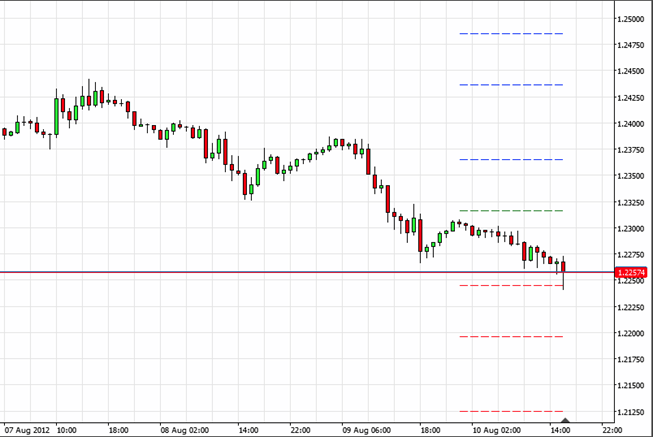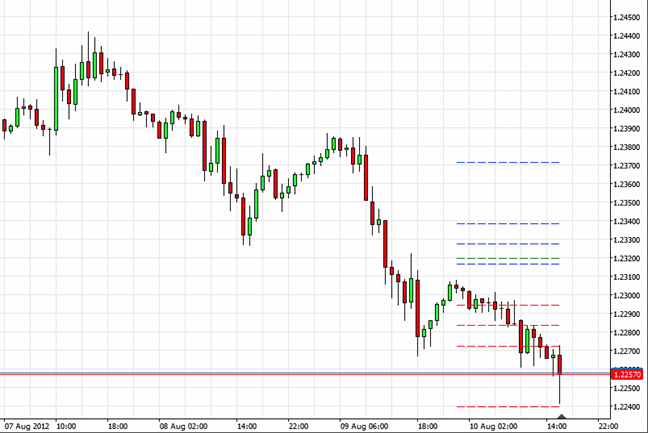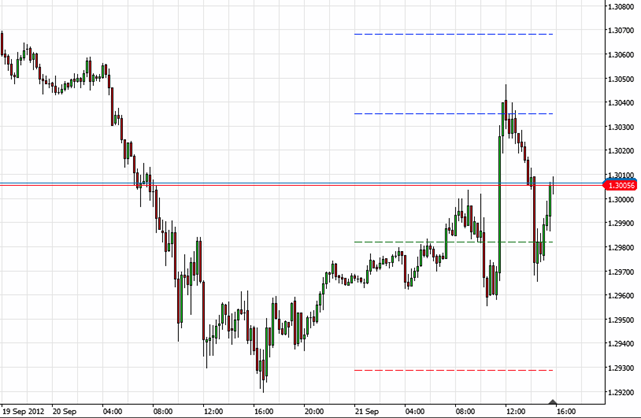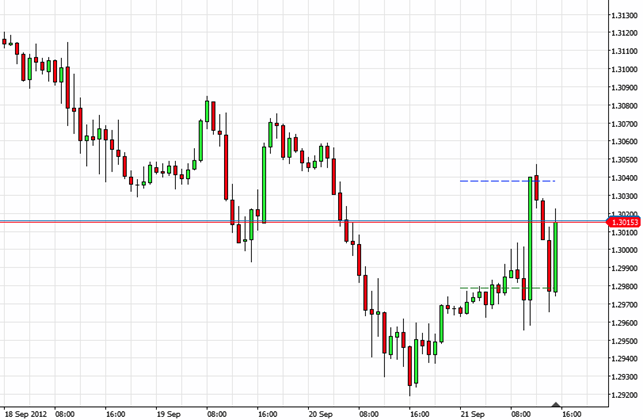-
TRADING
TRADING PLATFORM
Account type
Margin requirements
- TRADE RESOURCES
- INSTITUTIONAL SERVICE
- ABOUT
There are 4 ways to calculate pivot points:
R2 = PP + High – Low
R1 = (2 X PP) – Low
PP = (H + L + 2C) / 4
S1 = (2 X PP) – High
S2 = PP – High + Low
C – Closing Price, H – High, L – Low
As you may have noticed the Woodies Pivot calculation is quite different than the standard pivot points formula. One of the primary differences is that the Woodie’s formula puts more weight on the closing price. Notice that the Pivot Point (PP) calculation involves multiplying the closing price by 2, and then adding the High and Low. From this you would divide by 4 to get the PP level. This might sound a bit confusing at first, but essentially it works similar to an Exponential Moving Average, where the latter data is weighted more heavily than the earlier data. Also as a side note, you will often find in the FX market that the opening price is the same as the closing price. This is due to the fact that FX markets trade 24 hours a day.

Because they have different formulas, levels obtained through the Woodie calculations are very different from those gotten through the standard method. Some traders prefer to use the Woodie formulas because they give more weight to the closing price of the previous period.
Camarilla Pivot Points were invented by Nick Scott in the late 1980’s. They are similar in concept to Woodie’s in that they use the prior day’s closing price and range to compute the levels. But instead of 2 Resistance levels, and 2 Support levels, the Camarilla equation calls for 4 resistance levels and 4 support levels. Add to that the Pivot Point level, and there are a total of 9 levels plotted for Camarilla. Also, an interesting part of the Camarilla equation is that a special multiplier is included in the formula.
R4 = C + ((H-L) x 1.5000)
R3 = C + ((H-L) x 1.2500)
R2 = C + ((H-L) x 1.1666)
R1 = C + ((H-L) x 1.0833)
PP = (H + L + C) / 3
S1 = C – ((H-L) x 1.0833)
S2 = C – ((H-L) x 1.1666)
S3 = C – ((H-L) x 1.2500)
S4 = C – ((H-L) x 1.5000)
C – Closing Price, H – High, L – Low
As you can see, we have a total of 4 Resistance levels, and a total of 4 Support Levels. Many intraday traders utilize the Camarilla levels to fade price moves when then reach the R3 or S3 level. The idea is that the markets are cyclical in nature, and that a strong price move from the prior session, should tend to revert back within its value range the following day. Stops could be placed at the R4 or S4 levels. If, however, price action continues beyond the R4 or S4 level, then a stop and reverse can be initiated in anticipation for a strong trend day and continued price move beyond the R4 or S4 level.

Because of this, it’s possible that resistance levels could be below the pivot point or support levels could be above it.
Fibonacci studies such as retracements, extensions, and projections are quite popular in the Forex market. The primary Fibonacci levels that traders watch most closely are the 38.2% and 61.8% retracement levels. But did you know that you could incorporate these Fibonacci levels into a Pivot Point calculation as well? In fact, it is very similar to the Standard pivot points, with the additional inclusion of the 38.2% and 61.8% and 100% ratios.
R3 = PP + ((High – Low) x 1.000)
R2 = PP + ((High – Low) x .618)
R1 = PP + ((High – Low) x .382)
PP = (H + L + C) / 3
S1 = PP – ((High – Low) x .382)
S2 = PP – ((High – Low) x .618)
S3 = PP – ((High – Low) x 1.000)
C – Closing Price, H – High, L – Low
Fibonacci pivot point levels are determined by first calculating the pivot point like you would the standard method. Next, multiply the previous day’s range with its corresponding Fibonacci level. Most traders use the 38.2%, 61.8% and 100% retracements in their calculations. Finally, add or subtract the figures you get to the pivot point and you’ve got your Fibonacci pivot point levels!

The logic behind this is that many traders like using the Fibonacci ratios. People use it for retracement levels, moving averages, etc.
Demark Pivot points were introduced by Tom Demark, a famous technical analyst and trader. Demark Pivots are very different from other types of Pivot Points that we have discussed thus far. These pivot points have a conditional nature based on the relationship between the opening price and the closing price. Demark uses the number X to compute the upper resistance level and the lower support line.
Here is how you calculate Demark Pivot Points:
If C > O, then X = (2 x H) + L + C
If C < O, then X = H + (2 x L) + C
If C = O, then X = H + L + (2 x C)
PP = X/4
R1 = X/2 – Low
S1 = X/2 – High
C – Closing Price, O – Opening Price, H – High, L – Low
Demark Pivot Points place more emphasis on the recent price action. Many Demark traders use. Demark Pivot Points in conjunction with TD lines to find intraday support and resistance levels in the market. TD lines are much more objective than traditional trend lines. They are drawn from left to right based on the demand points in an uptrend and supply points in a downtrend. The objective is to find points along the TD line that are most likely prone to a breakout move.

*The information presented above is intended for informative and educational purposes, should not be considered as investment advice, or an offer or solicitation for a transaction in any financial instrument and thus should not be treated as such. Past performance is not a reliable indicator of future results.

Online Chat Chat with us
Email:supportsohomarkets.cc
Copyright © 2024 - All rights reserved.
Soho Markets Global Limited is an Investment Firm incorporated under the laws of Republic of Mauritius under number 181778 and registered address at Suite 803, 8th Floor, Hennessy Tower, Pope Hennessy Street,11328, Port Louis, Mauritius. Regulated by the Financial Service Commission (FSC) in Mauritius under license number GB21026599.
RISK WARNING: Soho Markets Global Ltd offers trading on Foreign Exchange (‘Forex or ‘FX) and Contracts for Difference (‘CFDs), which are complex financial products that are traded on margin. They carry a high level of risk since leverage can work both to your advantage and disadvantage. As a result, these products may not be suitable for all investors, as loss of all invested capital may occur. You should not risk more than you are prepared to lose. Before deciding to trade, you need to ensure that you understand the risks involved and consider your investment objectives and level of experience. Seek independent advice, if necessary.
Soho Markets Global Ltd does not issue advice, recommendations or opinions in relation to acquiring, holding or disposing of a CFD.
Soho Markets Global Ltd is not a financial advisor and all services are provided on an execution-only basis. This communication is not an offer or solicitation to enter into a transaction and shall not be construed as such.
This website is not directed at any jurisdiction and is not intended for any use that would be contrary to local law or regulation.
By using our you agree to use our cookies to enhance your experience.
Services are not available for residents of Turkey and United States of America
Telephone: +230 2146398
CLIENT AGREEMENT (TERMS AND CONDITIONS) Complaints or Grievances Policy Conflicts of Interest Policy Cookie Policy Order Execution Policy Privacy Policy Risk Disclosure